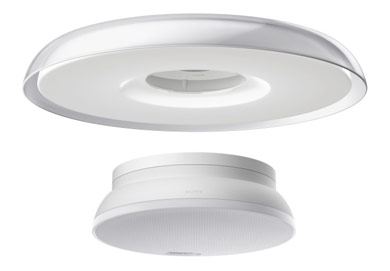As a late entrant in the LED luminaire market, Sony has been primarily focused on grabbing profits in the budding smart home market, and its recent product pricing strategies and new products launched clearly illustrate this approach of utilizing its experience in the consumer electronic industry to make value-added smart LED products.
 |
|
Sony's Ultra Short Throw Project from its Lifespace UX series product lineup. (All photos courtesy of Sony) |
Sony unveiled prices for its Lifespace UX series products showcased at CES 2016 were all in the high price range, reported Twice. The company’s Lifespace UX series products that will be available in MoMa stores this coming May are in the premium price range. The portable laser projector, Ultra Short Throw Project, will come with a hefty price tag of US $999, the most expensive item out of the company’s Lifespace UX product portfolio.
 |
|
Sony's speaker embedded LED filament bulb, Glass Sound Speaker. |
Other speaker embedded LED bulbs and luminaires with Bluetooth music streaming features from the product lineup are just as costly. The elegantly designed glass-cylinder shaped LED filament luminaire, Glass Sound Speaker, which is operated on batteries will cost consumers an astounding $799 per luminaire. Even the simply designed LED Bulb Speaker in the lower price range will cost at least $239.
 |
|
Sony's LED Bulb Speaker used in a living room setting. |
The current pricing scheme of Sony’s LED products suggests it is not targeting average consumers with affordable price-ranged products, and is moving away from low end products that are not only less profitable, but more prone to cutthroat pricing competitions. With high priced range products the company seems more eager to tap into the resources of tech savvy families, or high-end consumers that are willing to spend on smart home products, and boost its revenue from lighting products.
Sony’s Multifunctional Light targets the smart home market
Additionally, the company has launched a new Multifunctional Light in early January this year in Japan further affirms its LED market strategy of targeting smart home applications with value-added lighting products.
The Multifunctional Light product features clearly demonstrates this approach of integrating lighting with thermostats, speaker and audio functions. The LED ceiling light developed with the help of Toshiba LED technology is an IR remote controlled LED that integrates six sensors, including lighting sensors, proximity sensors, IR remote control sensors, microphones, and speakers.
There are two interesting features that stand out with this particular light that LEDinside has not seen in other manufacturers products. Markedly, it can make audio recordings and enable families to speak to each other via smartphones, and the embedded thermal sensors can help regulate air condition temperatures. Of course as a light it still retains basic lighting functions, such as dimming and color tuning, with a color temperature ranging between warm white colors of 2,700K to cool white 6,500K.
 |
|
Sony's Multifunctional Light is a smart LED ceiling light that integrates thermal sensors, audio recording, speakers, and lighting into a single device. |
Whether other manufacturers, such as Samsung, LG or Philips that have strong consumer electronic technologies backgrounds will adopt a similar strategy in the near future will be a trend worth noting. LEDinside expects new contestants in the smart home lighting market that are not traditional luminaire makers to remain an ongoing trend. Sony for instance is partnering with Toshiba to help bridge the gap in lighting technology for its Multifunctional Light design.
It will be interesting to see how far Sony will go with this lighting strategy, and whether smart home applications can help conventional lighting manufacturers break the curse of low profits with more innovative products.Sony’s message with its LED products is clear: “We are going beyond lighting.” It has the technology advantage to do so, and has been integrating different business arms technology into LED luminaires. For the most part, the LED luminaires launched so far, Glass Sound Speaker, LED Bulb Speaker, and Multifunctional Light play on its strength in audio and speaker technology by embedding it into bulbs. However, the Multifunctional Light is taking things a step further by integrating the group’s experience with smartphone technology.
(Author: Judy Lin, Chief Editor, LEDinside)















